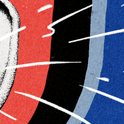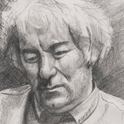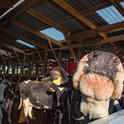Caught unawares: from Philip-Lorcia diCorcia's Heads
Photographic theory is packed with clichés: “the medium is essentially voyeuristic,” “the camera can lie” or even “the camera always lies.” But there is only so much philosophising anyone can take. And fortunately, as the 250 pictures in Tate Modern’s “Exposed” exhibition (which runs from 28th May to 3rd October) show, the images themselves are usually more interesting and unsettling than any theory spun about them. “Exposed” is subtitled “voyeurism, surveillance and the camera,” and its theme is images taken without the explicit permission of their subjects. Organised in five sections—The Unseen Photographer, Voyeurism and Desire, Celebrity and the Public Gaze, Witnessing Violence, and Surveillance—the show ranges from the late 19th century to the present and shuffles famous images alongside the works of anonymous and less-well-known photographers. The result is an arresting visual commentary on relationships of power and pleasure. When the photographer is unseen, people behave differently. Without the need to present a front or to pose, the mask may drop. Such candid photography makes the relationship between photographer and subject asymmetrical since it involves stalking the prey unseen and is essentially exploitative. The most remarkable examples of this way of working in “Exposed” are the work of the American Philip-Lorca diCorcia. For his series Heads (1999-2001), he used a telephoto lens and elaborate strobe lighting to photograph unsuspecting subjects in Times Square, catching ordinary people in absent-minded reflection. The strobe light abstracts them from their context, so they are isolated against a black background. The result is more poetic than documentary. Indeed, diCorcia’s works have been described as photographic Rorschach tests—ambiguous images that invite the viewer to project interpretations onto them. As with many of the images on show, we don’t know much about what was going on when the shutter fell—but we feel we do, and construct a narrative on the basis of that frozen moment. The implied story is usually more important than the reality. In the case of diCorcia, understandably, not everyone was delighted to discover that their image had become art: at least one inadvertent sitter has tried to sue the photographer for invasion of privacy—though without success. A different yet equally controversial take on reality is provided by Alison Jackson’s Queen Playing with Corgis (2007), in which a footman in livery is about to throw a ball for two dogs while the monarch, wearing wellies, looks on. This appears to be a classic paparazzi shot, using a telephoto lens from between the railings at Sandringham to catch its victim off-guard, revealing what we always suspected about her. Except it isn’t. It’s an ironic staging using a lookalike. Jackson specialises in irreverent pseudo “pap shots.” Her portfolio includes Mick Jagger having Botox injections, George W Bush in the Oval Office struggling to solve a Rubik’s Cube, Prince William semi-naked trying on a crown in front of a mirror and, perhaps most memorably, the Queen reading a magazine on the loo. The people captured in photographs can’t see you observing them, which makes it a near perfect medium for the sexual voyeur. Since photography’s inception, pornographers have exploited its seeming ability to reveal what you wouldn’t otherwise have seen—hence the tradition of “what the butler saw.” But having given us a peep at the birth of a pornographic tradition with explicit Victorian stereographic images, the curators shy away from following through this historical trajectory. A fuller history of photographic voyeurism would be closer to the censor’s radar, and would be impossible to show in a major gallery. Weegee—the pseudonym of American photographer Arthur Fellig—had a police radio, and used it to beat New York cops to crime scenes. He knew all about our fascination with death and suffering. In his classic 1941 shot Their First Murder, excited rubber-necking children crowd each other to get a view of the out-of-frame corpse. It is easy to be horrified by this bloodthirsty mob, but there is something of those children in all of us. And witnessing the effects of violence through photographs can simultaneously serve moral ends. Nick Ut’s unforgettable record of a child running from a napalm attack in south Vietnam—also on display here—helped change the public perception of a war. The photographic theorists are partly right, of course. Without independent information about what is in front of the lens, we never know exactly what we’re looking at. But as this exhibition shows, that needn’t stop us enjoying and learning from our imaginative engagement with what we think we can see.
Photographic theory is packed with clichés: “the medium is essentially voyeuristic,” “the camera can lie” or even “the camera always lies.” But there is only so much philosophising anyone can take. And fortunately, as the 250 pictures in Tate Modern’s “Exposed” exhibition (which runs from 28th May to 3rd October) show, the images themselves are usually more interesting and unsettling than any theory spun about them. “Exposed” is subtitled “voyeurism, surveillance and the camera,” and its theme is images taken without the explicit permission of their subjects. Organised in five sections—The Unseen Photographer, Voyeurism and Desire, Celebrity and the Public Gaze, Witnessing Violence, and Surveillance—the show ranges from the late 19th century to the present and shuffles famous images alongside the works of anonymous and less-well-known photographers. The result is an arresting visual commentary on relationships of power and pleasure. When the photographer is unseen, people behave differently. Without the need to present a front or to pose, the mask may drop. Such candid photography makes the relationship between photographer and subject asymmetrical since it involves stalking the prey unseen and is essentially exploitative. The most remarkable examples of this way of working in “Exposed” are the work of the American Philip-Lorca diCorcia. For his series Heads (1999-2001), he used a telephoto lens and elaborate strobe lighting to photograph unsuspecting subjects in Times Square, catching ordinary people in absent-minded reflection. The strobe light abstracts them from their context, so they are isolated against a black background. The result is more poetic than documentary. Indeed, diCorcia’s works have been described as photographic Rorschach tests—ambiguous images that invite the viewer to project interpretations onto them. As with many of the images on show, we don’t know much about what was going on when the shutter fell—but we feel we do, and construct a narrative on the basis of that frozen moment. The implied story is usually more important than the reality. In the case of diCorcia, understandably, not everyone was delighted to discover that their image had become art: at least one inadvertent sitter has tried to sue the photographer for invasion of privacy—though without success. A different yet equally controversial take on reality is provided by Alison Jackson’s Queen Playing with Corgis (2007), in which a footman in livery is about to throw a ball for two dogs while the monarch, wearing wellies, looks on. This appears to be a classic paparazzi shot, using a telephoto lens from between the railings at Sandringham to catch its victim off-guard, revealing what we always suspected about her. Except it isn’t. It’s an ironic staging using a lookalike. Jackson specialises in irreverent pseudo “pap shots.” Her portfolio includes Mick Jagger having Botox injections, George W Bush in the Oval Office struggling to solve a Rubik’s Cube, Prince William semi-naked trying on a crown in front of a mirror and, perhaps most memorably, the Queen reading a magazine on the loo. The people captured in photographs can’t see you observing them, which makes it a near perfect medium for the sexual voyeur. Since photography’s inception, pornographers have exploited its seeming ability to reveal what you wouldn’t otherwise have seen—hence the tradition of “what the butler saw.” But having given us a peep at the birth of a pornographic tradition with explicit Victorian stereographic images, the curators shy away from following through this historical trajectory. A fuller history of photographic voyeurism would be closer to the censor’s radar, and would be impossible to show in a major gallery. Weegee—the pseudonym of American photographer Arthur Fellig—had a police radio, and used it to beat New York cops to crime scenes. He knew all about our fascination with death and suffering. In his classic 1941 shot Their First Murder, excited rubber-necking children crowd each other to get a view of the out-of-frame corpse. It is easy to be horrified by this bloodthirsty mob, but there is something of those children in all of us. And witnessing the effects of violence through photographs can simultaneously serve moral ends. Nick Ut’s unforgettable record of a child running from a napalm attack in south Vietnam—also on display here—helped change the public perception of a war. The photographic theorists are partly right, of course. Without independent information about what is in front of the lens, we never know exactly what we’re looking at. But as this exhibition shows, that needn’t stop us enjoying and learning from our imaginative engagement with what we think we can see.













